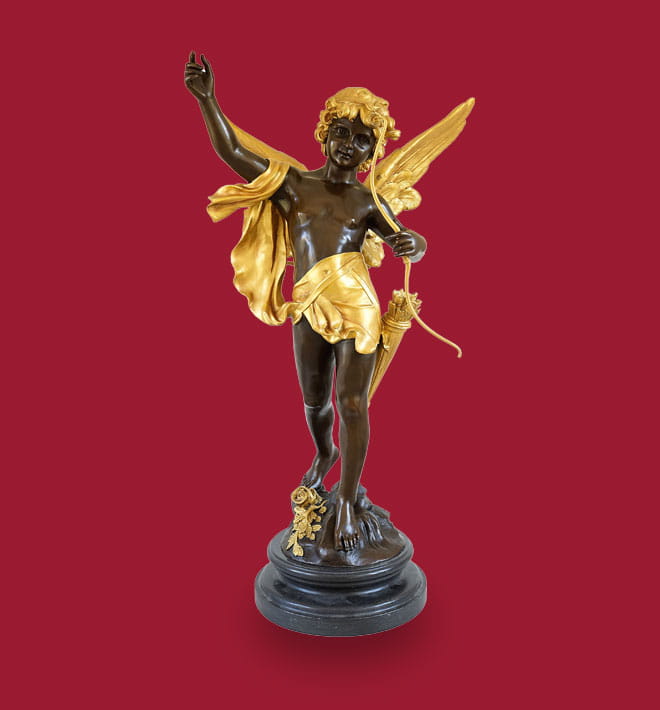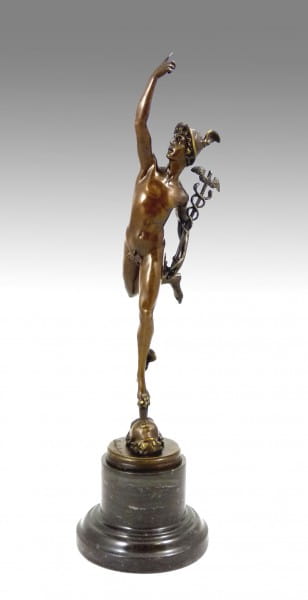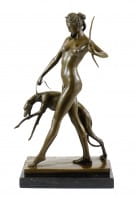€379.00 *
Prices incl. VAT, free shipping worldwide
Ready to ship today,
Delivery time appr. 3-6 workdays










Hermes Bronze Statue – An Exquisite Masterpiece of Greek Mythology by Giambologna Overview... more
Product description
"Hermes Bronze Statue - Giambologna - Greek Mythology"
| Weight | 2,4 kg |
Hermes Bronze Statue – An Exquisite Masterpiece of Greek Mythology by Giambologna
Overview
This exceptional bronze sculpture depicts Hermes, also known as Mercury in Roman mythology, the god of commerce, communication, and travel. Designed by the renowned Italian sculptor Giambologna (1529-1608), this piece is a perfect representation of the Renaissance period’s appreciation for classical mythology and artistic beauty. Standing in a poised, dynamic stance, this statue captures both the elegance and athleticism of the messenger god, making it a timeless addition to any fine art collection.
The Renaissance Revival of Greek Mythology
Giambologna, originally named Jean Boulogne, was a celebrated sculptor from Flanders who made his mark in Florence, Italy, under the patronage of the powerful Medici family. The Renaissance was a time when artists and thinkers across Europe revived interest in ancient Greek and Roman culture, using mythological figures as symbols of various human virtues and universal truths. Hermes, known for his wit, swiftness, and adaptability, became a popular subject in Renaissance art as he embodied qualities celebrated in commerce, diplomacy, and exploration – ideals resonant with the flourishing city-states of the time.
The Iconography of Hermes – Symbolism and Attributes
The statue embodies Hermes’ essential characteristics through classical iconography. Hermes is depicted mid-stride, one foot elegantly balanced on a globe, symbolizing his connection with travel and communication across the world. His right arm is raised skyward, a gesture indicating his role as a divine messenger between gods and humans. In his left hand, he holds the caduceus, a staff entwined by two serpents and topped with wings. The caduceus is a timeless symbol associated with peace, negotiation, and healing.
Adding to his iconic appearance, Hermes wears the petasos—a winged helmet symbolizing agility and speed. His body is crafted with meticulous detail, capturing the muscular structure and smooth lines of his form, which convey a sense of movement and elegance. Giambologna’s choice to depict Hermes as a youthful, agile figure reflects Renaissance ideals of physical beauty and intellectual prowess.
Artistic Process and Bronze Casting Techniques
Giambologna’s original sculpture of Hermes was crafted during the late 16th century, using a lost-wax casting technique—a traditional process that dates back thousands of years and was perfected during the Renaissance. In this technique, a wax model is created and encased in a mold. When heated, the wax melts away, leaving a cavity in the mold that is filled with molten bronze. Once cooled, the mold is removed, revealing a solid bronze figure with extraordinary detail and durability.
This reproduction maintains the same artisanal care in casting, patination, and polishing, ensuring that every line and contour honors the original creation. The rich, warm tones of the bronze highlight the exquisite craftsmanship, while the polished marble base provides a sophisticated foundation for the statue.
Giambologna’s Legacy and the Enduring Appeal of Hermes
Giambologna’s Hermes stands as a testament to the enduring fascination with Greek mythology and its allegorical richness. Hermes symbolizes intelligence, resourcefulness, and quick thinking, qualities that transcend time and culture. His image in art serves as a reminder of humanity’s potential to connect, communicate, and innovate.
This sculpture by Giambologna is not merely an artwork; it is a bridge to the cultural heritage of ancient Greece and the Renaissance, resonating with themes of transcendence, connection, and intellectual curiosity. The statue is ideal for collectors, history enthusiasts, or anyone with a deep appreciation for classical mythology and its aesthetic embodiment.
Conclusion – A Timeless Masterpiece for Art Connoisseurs
Whether displayed in a private study, an art gallery, or a luxurious living room, this Hermes Bronze Statue by Giambologna exudes sophistication and historical depth. It is a piece that speaks to the soul of art collectors, reminding us of our shared cultural heritage and the timeless myths that continue to inspire humanity.
Indulge in the legacy of one of the Renaissance's greatest sculptors and bring home a piece that not only celebrates Hermes but also the artistic ideals of an era that prized beauty, intelligence, and refinement. This statue is more than decor; it is a symbol, an inspiration, and a work of art that captures the essence of Giambologna’s genius.
Overview
This exceptional bronze sculpture depicts Hermes, also known as Mercury in Roman mythology, the god of commerce, communication, and travel. Designed by the renowned Italian sculptor Giambologna (1529-1608), this piece is a perfect representation of the Renaissance period’s appreciation for classical mythology and artistic beauty. Standing in a poised, dynamic stance, this statue captures both the elegance and athleticism of the messenger god, making it a timeless addition to any fine art collection.
The Renaissance Revival of Greek Mythology
Giambologna, originally named Jean Boulogne, was a celebrated sculptor from Flanders who made his mark in Florence, Italy, under the patronage of the powerful Medici family. The Renaissance was a time when artists and thinkers across Europe revived interest in ancient Greek and Roman culture, using mythological figures as symbols of various human virtues and universal truths. Hermes, known for his wit, swiftness, and adaptability, became a popular subject in Renaissance art as he embodied qualities celebrated in commerce, diplomacy, and exploration – ideals resonant with the flourishing city-states of the time.
The Iconography of Hermes – Symbolism and Attributes
The statue embodies Hermes’ essential characteristics through classical iconography. Hermes is depicted mid-stride, one foot elegantly balanced on a globe, symbolizing his connection with travel and communication across the world. His right arm is raised skyward, a gesture indicating his role as a divine messenger between gods and humans. In his left hand, he holds the caduceus, a staff entwined by two serpents and topped with wings. The caduceus is a timeless symbol associated with peace, negotiation, and healing.
Adding to his iconic appearance, Hermes wears the petasos—a winged helmet symbolizing agility and speed. His body is crafted with meticulous detail, capturing the muscular structure and smooth lines of his form, which convey a sense of movement and elegance. Giambologna’s choice to depict Hermes as a youthful, agile figure reflects Renaissance ideals of physical beauty and intellectual prowess.
Artistic Process and Bronze Casting Techniques
Giambologna’s original sculpture of Hermes was crafted during the late 16th century, using a lost-wax casting technique—a traditional process that dates back thousands of years and was perfected during the Renaissance. In this technique, a wax model is created and encased in a mold. When heated, the wax melts away, leaving a cavity in the mold that is filled with molten bronze. Once cooled, the mold is removed, revealing a solid bronze figure with extraordinary detail and durability.
This reproduction maintains the same artisanal care in casting, patination, and polishing, ensuring that every line and contour honors the original creation. The rich, warm tones of the bronze highlight the exquisite craftsmanship, while the polished marble base provides a sophisticated foundation for the statue.
Giambologna’s Legacy and the Enduring Appeal of Hermes
Giambologna’s Hermes stands as a testament to the enduring fascination with Greek mythology and its allegorical richness. Hermes symbolizes intelligence, resourcefulness, and quick thinking, qualities that transcend time and culture. His image in art serves as a reminder of humanity’s potential to connect, communicate, and innovate.
This sculpture by Giambologna is not merely an artwork; it is a bridge to the cultural heritage of ancient Greece and the Renaissance, resonating with themes of transcendence, connection, and intellectual curiosity. The statue is ideal for collectors, history enthusiasts, or anyone with a deep appreciation for classical mythology and its aesthetic embodiment.
Conclusion – A Timeless Masterpiece for Art Connoisseurs
Whether displayed in a private study, an art gallery, or a luxurious living room, this Hermes Bronze Statue by Giambologna exudes sophistication and historical depth. It is a piece that speaks to the soul of art collectors, reminding us of our shared cultural heritage and the timeless myths that continue to inspire humanity.
Indulge in the legacy of one of the Renaissance's greatest sculptors and bring home a piece that not only celebrates Hermes but also the artistic ideals of an era that prized beauty, intelligence, and refinement. This statue is more than decor; it is a symbol, an inspiration, and a work of art that captures the essence of Giambologna’s genius.
Width: 15,5 cm
Height: 43 cm
Depth: 12 cm
Weight: 2,4 kg
100% Bronze
Related links to "Hermes Bronze Statue - Giambologna - Greek Mythology"
Read, write and discuss reviews... more
Customer evaluation for "Hermes Bronze Statue - Giambologna - Greek Mythology"
Write an evaluation
Evaluations will be activated after verification.
Our advantages
free shipping
Worldwide free shipping
14 days money back
You can cancel your order
within 14 days
secure payment services
Paypal, Master Card, Visa, American Express and more






















































